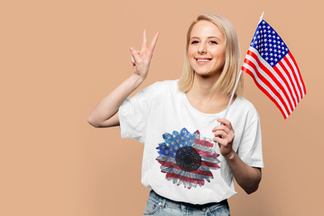When it comes to customizing apparel and accessories, two popular methods stand out: embroidery vs (DTF) printing. While both techniques allow for creative designs, they offer unique benefits depending on your needs. In this post, we’ll explore the key differences between Embroidery vs DTF, helping you decide which is best for your next custom project.
What Is Embroidery?
Embroidery is a classic and durable customization method that involves stitching a design directly onto fabric using threads. This technique has been around for centuries and is known for creating an elegant, tactile look and feel.
Key Features of Embroidery:
Professional & Textured Appearance: Embroidery is perfect for logos and designs that need a professional, polished finish. The raised, textured feel of the stitched design gives it a premium, long-lasting look.
Durability: Embroidery is known for its resilience. The thread used in embroidery is resistant to fading, fraying, and general wear, making it an ideal choice for items that will see frequent use, like uniforms, hats, and jackets.
Limited Detail & Color Blending: Embroidery is best suited for designs that are simpler and use fewer colors. It’s not ideal for intricate patterns, shading, or photorealistic images, as the thread doesn’t allow for smooth color gradients.
Ideal for Heavy Fabrics: Heavier fabrics like cotton, denim, and canvas work particularly well with embroidery. The technique adds a rich texture that enhances the look of thicker materials.
Best Uses for Embroidery:
Corporate uniforms
Hats & caps
Bags & backpacks
Jackets
Sports team logos
What Is DTF Printing?
Direct-to-Film (DTF) printing is a newer method that involves printing designs onto a special film and then transferring the image onto fabric using heat and adhesive. Unlike embroidery, DTF allows for detailed and vibrant full-color prints with ease.
Key Features of DTF Printing:
High Detail & Vibrant Colors: DTF excels at capturing fine details and photorealistic images. It can easily reproduce complex designs with multiple colors, smooth gradients, and small text, making it ideal for intricate designs.
Versatile Application: DTF can be applied to a wide variety of materials, from cotton and polyester to blends and even synthetics. It’s great for t-shirts, sportswear, and items that require high flexibility.
Smooth Finish: Unlike the textured feel of embroidery, DTF leaves a smooth finish on the fabric. The result is a soft-to-the-touch design that integrates seamlessly with the material.
Fast & Cost-Effective for Small Orders: DTF printing allows for quick turnaround times and is often more affordable for small batch orders compared to embroidery, especially for full-color designs.
Best Uses for DTF Printing:
T-shirts & hoodies
Activewear & sports uniforms
Promotional items
Full-color designs & artwork
Custom one-off prints
Comparing Embroidery vs DTF:
Aspect | Embroidery | DTF Printing |
Look & Feel | Textured, raised, premium | Smooth, soft-to-touch, vibrant |
Durability | Extremely durable and long-lasting | Durable but may fade over time |
Design Complexity | Best for simple designs and logos | Handles complex, multicolored designs |
Material Suitability | Works well on heavy fabrics | Versatile, works on a wide range of fabrics |
Cost | Higher cost for complex designs | More cost-effective for full-color and small orders |
Production Time | Longer for intricate designs | Quick turnaround for custom prints |
When to Choose Embroidery:
Embroidery is the perfect choice if you’re looking for a timeless, professional look. It’s especially effective for corporate branding, sports team logos, and promotional items where durability and a premium finish are key. Embroidery is best suited for sturdy fabrics and simpler designs that don’t require intricate detail or color blending.
When to Choose DTF Printing:
DTF is ideal for projects that require vivid colors, intricate details, and fast production. Whether it’s a custom t-shirt with a photorealistic image or a promotional product with a detailed graphic, DTF delivers high-quality results at a lower cost for smaller quantities. DTF printing is versatile, making it a go-to option for a wide range of fabrics and designs.
Final Thoughts:
Both embroidery and DTF printing have their advantages, and the best method depends on your specific project needs. If you want a durable, professional-looking design with a textured feel, go for embroidery. If you need vibrant, detailed prints with a smooth finish and fast turnaround, DTF is the way to go.
Ready to start your next project? Visit Graphix Unleashed to explore our embroidery and DTF printing services and create custom gear that’s perfect for you!
Related Links:
Learn more about our embroidery services.
Check out our DTF printing options. Contact us for a free quote or for more information.
Shop custom gear for the Impact Soccer Club.










Comments